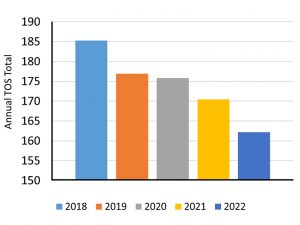The misinformation in our industry is pervasive. Daily headlines are loaded with stuff from reports, studies and news releases that just ain’t so.
Let me give an example of a recent Moody’s report on transmission.[1] (See Moody’s: Permitting Process Holding Transmission Back, Risking Reliability.)
Moody’s bases its case for investment in transmission in part on aged infrastructure causing reliability and other problems. Let’s check out its claims.
Transmission Outage Events
Exhibit 1 from its report is reprinted here, with Moody’s saying that transmission outage events have more than doubled between 2009-2014 and 2015-2021.
This is not valid analysis. Starting in 2015, NERC expanded the facilities subject to reporting from 200 kV and above, to 100 kV and above.[2] The number of facilities (elements) subject to reporting increased from 7,098 to 23,835, and the number of subject circuit miles increased from 181,427 to 454,316.[3] So the increase in reported outages has everything to do with a larger number of subject facilities and circuit miles, and nothing to do with transmission system reliability.
NERC provides the trend in transmission system reliability in the chart reprinted here, saying that: “The Bulk Electric System (BES) transmission system continues to demonstrate significantly improved reliability for the fifth year in a row.”[4]
Congestion
Congestion is the additional cost of dispatching higher cost generation due to a transmission constraint. Moody’s says that congestion costs in the Mid-Atlantic region surged from $528.7 million in 2020 to $995.3 million in 2021, surpassing “energy costs.”
The increase in congestion costs from 2020 to 2021 had everything to do with increases in fossil fuel costs (energy clearing prices increased from $21.77/MWh to $39.78/MWh largely due to higher fuel and emission costs)[5] — nothing to do with transmission system inadequacies.
As for the claim that congestion costs of $995.3 million exceeded energy costs, energy costs were $30.5 billion in 2021.[6] So congestion costs were a minor 3% of energy costs, hardly more than energy costs. And customers were shielded against much of those relatively minor congestion costs through financial transmission rights.[7]
Moody’s sources its invalid congestion claims to DOE’s draft “National Transmission Needs Study,” so let me address a couple more misjudgments that appear there.[8] DOE says the “transmission constraint shadow price” almost doubled from 2020 to 2021. This simply reflects higher fuel prices. How do we know that? Because the frequency of transmission constraints actually declined from 117,867 to 102,529.[9]
Then DOE says that in 2021 the “transmission price component” was more than the “capacity price component” for the first time since 2007, which isn’t exactly true, but in any event would suggest transmission system spending is going up – a non sequitur for any claim of growing transmission inadequacy.
Transmission Facilities’ Life Expectancy
Moody’s says that transmission lines and transformers are mostly beyond their life expectancies.
Regarding its claim that transmission lines have a life expectancy of 50 years, the reality for transmission lines is 80+ years[10] to “essentially forever.”[11]
Regarding its claim that transformers have a life expectancy of 25 years, the cited authority states that this is based on continuous loading at the rated (maximum) capacity,[12] which simply does not happen. The reality is that transformers on average last much longer than that.[13]
BTW, the most important reliability element for transformers is that we maintain an inventory available to replace transformers as failures occur. (Hint to RTOs and TOs: Any transformers retired before failure should be kept in reserve for this purpose.)
Texas
Moody’s is right about one thing: Interregional transmission ties into Texas would have avoided vast costs and outages during Winter Storm Uri (not to mention saved lives).
But as I have written before, that problem has to do with Texas’ self-imposed isolation because of its (groundless) concern about losing Texas’ independence.[14] Nothing to do with transmission system inadequacies.
Bottom Line
We should keep the current condition of the transmission system — which is generally sound — separate from the need to expand the system for the energy transition. I’ve had a few thoughts on the latter for anyone interested.[15]
Columnist Steve Huntoon, principal of Energy Counsel LLP, and a former president of the Energy Bar Association, has been practicing energy law for more than 30 years.
[1] https://www.moodys.com/research/Regulated-Electric-and-Gas-Utilities-US-Transmission-investment-opportunities-abound-Sector-In-Depth–PBC_1377533.
[2] https://www.energy.gov/oe/articles/annual-us-transmission-data-review-2015, page 3 and footnote 6.
[3] https://www.nerc.com/pa/RAPA/tads/SiteAssets/TADS_Dashboard_Supporting_Data.xlsx, columns under “Inventory Counts.”
[4] https://www.nerc.com/pa/RAPA/PA/Performance%20Analysis%20DL/NERC_SOR_2023_Overview.pdf, page 11.
[5] https://www.monitoringanalytics.com/reports/PJM_State_of_the_Market/2021/2021-som-pjm-vol1.pdf, page 1.
[6] https://www.monitoringanalytics.com/reports/PJM_State_of_the_Market/2021/2021-som-pjm-vol1.pdf, page 18, Table 8.
[7] https://www.monitoringanalytics.com/reports/PJM_State_of_the_Market/2021/2021-som-pjm-vol1.pdf, page 72.
[8] https://www.energy.gov/sites/default/files/2023-02/022423-DRAFTNeedsStudyforPublicComment.pdf, page 64.
[9] https://www.monitoringanalytics.com/reports/PJM_State_of_the_Market/2021/2021-som-pjm-sec3.pdf, page 175, Table 3-54.
[10] https://www.xcelenergy.com/staticfiles/xe/Corporate/Corporate%20PDFs/OverheadVsUnderground_FactSheet.pdf
[11] https://engineering.mit.edu/engage/ask-an-engineer/how-do-electricity-transmission-lines-withstand-a-lifetime-of-exposure-to-the-elements/; https://www.tdworld.com/intelligent-undergrounding/article/21215620/overhead-or-underground-transmission-that-is-still-the-question.
[12] https://www.electricaltechnology.org/2019/12/average-life-expectancy-transformer.html
[13] https://teamuis.com/2021/01/07/how-long-does-a-power-transformer-last-forever/
[14] https://www.energy-counsel.com/docs/a-modest-proposal.pdf
[15] https://energy-counsel.com/wp-content/uploads/2023/02/Big-Transmision-Still-Not-the-Right-Stuff.pdf; https://energy-counsel.com/wp-content/uploads/2022/04/Stop-the-Insanity.pdf.


